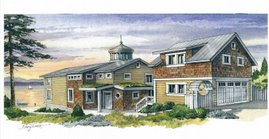One of the things that we pride ourselves on here at GGATB is that we have effectively reduced significantly our storm water runoff. Why is this important? First of all, every time we humans erect a building or lay pavement we alter the natural hydrological cycle. The way it's supposed to work is that when rain falls, about 50% of it infiltrates back into the soil and underlying aquifer, 40% gets absorbed back into the air through evapotranspiration, and only about 10% is actual "runoff." See the graphic below:
Source: www.aucklandcity.govt.nz
But once we start filling up land with buildings and pavement, that natural cycle gets circumvented. In a city where you could have 75-100% impervious surfaces (hard surfaces like buildings and roads that don't absorb water) the infiltration is reduced to a mere 15% and up to 55% is now runoff.
And why is that a problem? Well, first of all, all that water needs somewhere now to go. Which means that cities have to figure out ways to transfer it off of the streets into storm drains. Stormwater management is one of the most costly and troubling issues that cities face: Where to send it, how to treat it, etc. Second, all that stormwater now carries in it all the pollutants that were sitting around on roadways or chemicals from landscaping, etc. The water is no longer safe to send back into the aquifer or out to streams, rivers, and oceans. It has to be treated somehow. But that's only the water that is actually collected in storm drains. There is a significant amount of water that just runs off into local bodies of water, taking with it poisons that wreak havoc on the marine life and potable water sources.

 So back to GGATB...we are particularly sensitive to storm water runoff since most of it would go straight into the fragile Puget Sound right outside our door. We opted for pervious concrete which is basically concrete without the sand. It has a texture like a Rice Krispies Treats© and those spaces between the solids allow water to percolate right through. Our pervious concrete is about 4" thick and lays on top 18" of sand, gravel and broken up recycled conventional concrete that came from the old foundation of the cabin. This substrate gives the water somewhere to go as it trickles down through and back into the aquifer below. The permeable pavers work in a similar fashion. They are designed in such a way that there are spaces between them. They also sit on an 18" substrate so that water can go down between them into the ground.
So back to GGATB...we are particularly sensitive to storm water runoff since most of it would go straight into the fragile Puget Sound right outside our door. We opted for pervious concrete which is basically concrete without the sand. It has a texture like a Rice Krispies Treats© and those spaces between the solids allow water to percolate right through. Our pervious concrete is about 4" thick and lays on top 18" of sand, gravel and broken up recycled conventional concrete that came from the old foundation of the cabin. This substrate gives the water somewhere to go as it trickles down through and back into the aquifer below. The permeable pavers work in a similar fashion. They are designed in such a way that there are spaces between them. They also sit on an 18" substrate so that water can go down between them into the ground.How's it working? Great! After more than 4 years with only 2 power washings (which we hate to do because it uses so much potable water! Would that some company would come up with a way to use greywater for power washing!) the pervious concrete is happily sucking up all the storm water that nature can throw at it. Some folks have asked about the impact of freezing. We do get some significant freezing periods (up to a week at times) but this has not caused any problems that we can see. Neither does sand or dirt. Even though we live at the beach and a good deal of sand get traipsed up from the shore it doesn't seem to inhibit the concrete abilities at all. So far so good.
Likewise for the permeable pavers. The spaces between make for great little micro-gardens for sedums spreading from the green roof, moss (a Pacific NW perennial!) and the occasional weed but even if we let these take root they don't diminish the permeability. No standing water or rivers of water on this property!
For more on storm water mitigation and issues watch the educational videos at our PorterWorks YouTube channel: http://www.youtube.com/user/PorterWorks/videos?sort=dd&view=0&page=2.

No comments:
Post a Comment